
Since October of 2017, intrigue and mystery has surrounded Luis Elizondo. He is a former Department of Defense (DoD) employee who says that during his time working inside the Pentagon, he headed a secret UFO study known as the Advanced Aerospace Threat Identification Program (AATIP). His story quickly spread throughout the mainstream media garnering international attention, and people became enthralled by the idea that behind the scenes, the U.S. government was actively investigating UFOs and most likely hiding everything it knew. But despite the praise and adoration by many, Elizondo’s journey of stepping into a global spotlight would not come without many challenges for him to overcome.
It would take just under two months for Elizondo to receive some push back from his former employer which challenged some of his claims. Then, about a year and a half after he went public, the Pentagon would fire a more precise shot across the bow to directly target Elizondo’s integrity with what seemed to be a damning statement. They told The Intercept in June of 2019 that Elizondo had no “responsibilities” on the AATIP (this would later be amended to “no assigned responsibilities”). Armed only with official statements, but offering no supporting documentation, it appeared that the Pentagon had a concerted effort to negate everything that Elizondo had brought forward to the public.
Now, more than three and a half years after Elizondo told his extraordinary story about investigating unidentified aerial threats for the U.S. government, the saga has taken an unexpected turn. The DoD has now admitted exclusively to The Black Vault that they have destroyed some of the most crucial evidence that could either prove, or disprove, Elizondo’s work history within a secret UFO study known as AATIP.
The discovery came when the DoD sent The Black Vault a “final determination” letter after three years of numerous FOIA requests and multiple appeals seeking out Elizondo’s e-mails. Despite a number of those appeals being granted, and what seemed like numerous wins in an effort to finally uncover the truth, the three-year-long effort came to a dead end when the first of many remanded appeals was finally answered.
“After thorough searches of the electronic records and files of OUSD (I&S), no records of the kind you described [Elizondo e-mails containing the word “unidentified”] could be identified. Please note that e-mails of former Department of Defense (DoD) employees are not retained unless they are considered historical records and retained by the National Records Center. There are currently no existing e-mail accounts for Mr. Elizondo. We believe that search methods were appropriate and could reasonably be expected to produce the requested records if they existed.”
Essentially saying the records were destroyed, The Black Vault reached out to clarify. The DoD has now confirmed nearly two months after they wrote the letter, that their final determination does equate to Elizondo’s emails being destroyed with no backup available. Beyond confirmation of that, they offer no official statement explaining or expanding on the situation.
What is unclear, is whether or not the deletion of these electronic records was authorized by protocol. To delete records such as these, set procedures followed by the agency called “record retention schedules” need to have certain prerequisites met in order to delete or destroy files. However, after extensive research on these schedules, consultation with Elizondo about his work history, and a near two-month effort to get clarification from the DoD on what authorized them to do this, it appears there may be no adequate authorization that can be cited for this destruction to have taken place.
Although The Black Vault aimed to have a published explanation from the DoD for this article, a near two-month attempt to do that, failed. In that amount of time, the DoD was continually unable to cite any specific protocol, procedure or schedule that would authorize the destruction of Elizondo’s e-mails. Further, they would not by the writing of this article, submit any additional explanation or offer a statement.
Setting the Record Straight on Elizondo
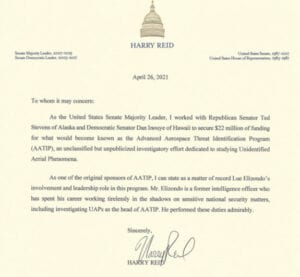
With the mounting hurdles Elizondo has been faced with, the situation has resulted in an official DoD Inspector General evaluation after a complaint was filed by Elizondo’s attorney on his behalf. In addition to his legal representation, Elizondo also does not march alone with his attempts to prove his past duties. He comes with a powerful ally who said he saw Elizondo’s work first-hand.
On April 26, 2021, former Senator Harry Reid restated his previous 2019 endorsement of Elizondo’s directorship and involvement in the AATIP, and that letter was first received by NBC News investigative journalist Gadi Schwartz. “As one of the original sponsors of AATIP, I can state as a matter of record Lue Elizondo’s involvement and leadership in this program,” Reid said in a blanket statement to all concerned.
The Black Vault sent this letter to the Pentagon the next day for comment, yet, they did not waver on their stance they’ve now held for nearly two years. The Pentagon restated directly to The Black Vault their claim about Elizondo not having any “assigned responsibilities” on AATIP, and they further would not comment on Senator Reid’s letter or his clear endorsement of Elizondo’s claims.
When asked to clarify why the word “assigned” was added in 2019, and what it exactly meant since it was the cause of much confusion, Pentagon Spokesperson Susan Gough stated to The Black Vault simply that, “…assigned responsibilities are an individual employee’s duties.” Follow-ups seeking more clarity to that short statement have remained unanswered as of the writing of this article.
But despite the Pentagon’s steadfast claim about Elizondo’s background and work history on AATIP; a new development surfaced while researching this story. Just weeks after Elizondo stated during a press conference that he was still “actively engaged” in what is known as the UAP Task Force (UAPTF), the U.S. military’s present day effort to investigate UFOs announced in August of 2020, the Pentagon yet again challenged Elizondo’s assertion when asked by The Black Vault.
“Luis Elizondo departed the Department of Defense in October 2017,” Gough said. “He has no position in the UAPTF, and the UAPTF has not involved him in its ongoing work.”
The Black Vault contacted Elizondo for his reaction to this newest development. He expressed his frustration:
“As for my work behind the scenes to support UAP Task Force efforts, I have been patient in allowing the Pentagon to address this in a manner they are comfortable provided they do not lie. Unfortunately, it now seems they are choosing once again to obscure the truth,” Elizondo said. “As in other instances, I have initiated efforts internally that will hopefully encourage the Pentagon PAO to provide more truthful information to the public. Beyond that, I care to withhold additional comment at this point and allow every opportunity for the system to correct itself. However, my reserve is not endless, nor is my patience.”
Gough, a Pentagon Strategic Planner & Spokesperson since March of 2009, has spearheaded the effort to comment on Elizondo and UAPs in recent years. She is currently the only to be attributed as doing so on behalf of the U.S. government. She handles, solely, all enquiries from the media regarding UAPs and Elizondo submitted to the DOD, Defense Intelligence Agency (DIA), Navy, Air Force, fields all questions on the UAPTF, and appears to be coordinated with on all FOIA releases regarding the same. According to internal DoD e-mails released via the FOIA, this is to ensure that “new terms/language/etc. aren’t introduced that complicate the overall messaging efforts.” Her involvement as a spokesperson being involved in the FOIA process remains highly controversial.
Gough’s background prior to commenting on UAPs for the Pentagon has not made her popular to many online UFO “‘D’isclosure” advocates. In 2003, she authored a Strategy Research Project where she wrote that the “orchestrated combination” of public diplomacy, psychological operations (PsyOps), and public affairs is the definition of what is called “strategic influence.” She adds that the “DoD needs someone with the appropriate position and authority to oversee the policy and to coordinate DoD strategic influence activities among DoD public affairs, military PSYOP, and other military information activities.”
This work involving PsyOps and public affairs concerns many that her message is based less on truth, and more focused on “strategically influencing” the general public.
It is unclear if Gough played a role in the original crafted 2019 “no responsibilities” statement about Elizondo, as attributed to Pentagon Spokesperson Christopher Sherwood and published by The Intercept. However, it is clear that Gough exclusively took over commenting shortly after that was printed. Since then, she appears to be strategically fine-tuning their overall messaging with numerous other statements pertaining to UAPs and Elizondo as printed by numerous media outlets. She even submitted a corrected statement to a previous position on AATIP and UFOs for a December 2019 report written by The Black Vault. She stated that Sherwood, who told the NY Post AATIP investigated UFOs, was wrong. Gough changed the Pentagon’s stance by saying, “Neither AATIP nor [Advanced Aerospace Weapon Systems Applications Program] were UAP related.” Though despite that claim, more than a year later in May of 2021, that correction seems to now be altered again by a new stance sent out by Gough to The Black Vault saying that AATIP utilized “reports of UAPs”. As a result, more confusion has ensued to those trying to make sense of the contradicting information and to those attempting to unravel what the AATIP was truly about.
The Value of a Paper Trail
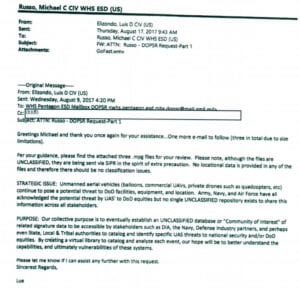
As Gough remains the only current contact that will comment on AATIP, UAP, or Elizondo related matters, it appears that at least to her, even endorsements from a former Senate Majority Leader will not make the Pentagon change their stance on Elizondo or the true scope of AATIP. Therefore, for those seeking official documentation to support either side, that hunt would need to be done through legal channels and the use of the FOIA. That tool would allow access to evidence that could certainly prove, or even disprove, Elizondo’s story all together.
Specifically, that evidence would include the official communication workload generated by Elizondo himself while he said he was working on the program.
Throughout anyone’s career, especially in government, a paper trail exists that would stretch beyond hundreds, thousands, even tens of thousands of pages over the course of a decade+ long employment such as Elizondo’s. Part of that paper trail would largely exist in the form of e-mails that could pertain to Elizondo’s day to day operations and duties; AATIP or UFO related messages; communications with his superiors; even just personal chatter between Elizondo and other DOD staff.
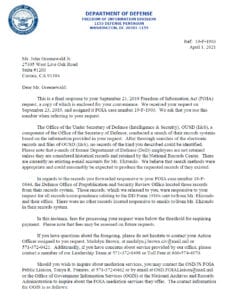
However, as stated above, it is now confirmed the general public will never see any of that. In a stunning admission by the DoD, that electronic paper trail in the form of e-mails generated and received by Elizondo, have all been destroyed. The entire electronic cache of data and evidence has been deleted, with no backup available.
Although Elizondo expresses doubts that the statement is even true, he also sent his reaction to The Black Vault after he learned about the DoD’s announcement of his e-mails being deleted.
“If the statement by the Pentagon is true, which I am not convinced that it is, this would be a significant loss of information that belongs to the public and may even be relevant to future legal efforts. It is also becoming increasingly evident that the destruction of my e-mails, etc. may be a convenient tactic to obscure the truth of my involvement in national security activities. I sincerely hope this is not the case.”
“Future Legal Efforts”
Elizondo’s reference to “future legal efforts” could have more than one meaning. Despite the DoD/OIG evaluation currently ongoing, The Black Vault made a discovery in 2019 that offered a previously unseen glimpse into the life of Elizondo.
Away from his story about AATIP, UAPs and all things unidentified, Elizondo’s official title within the DoD when he resigned was “Director, National Programs Special Management Staff, OUSD(I).” The National Programs Special Management Staff (NPSMS) was mostly overlooked by researchers seeking the truth about Elizondo’s background. The Black Vault had dug in to uncover what that office was all about, and after years of searching, there was not much to be found. This was possibly due to the sensitivity surrounding the day-to-day work within.
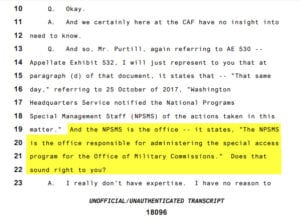
In the only official documents uncovered that references the NPSMS, it was revealed that Elizondo’s office he directed would play an instrumental role during the military trial of 9/11 mastermind Khalid Sheikh Mohammed or KSM. In a 2017 military court transcript, KSM’s attorney David Nevin made reference to the NPSMS, and called them the “SAP Access People.” It appeared by the dialogue between Nevin and the judge presiding over the case, that the NPSMS controlled the Special Access Program (SAP) access for the defense teams interpreter. That access was required for the interpreter to hold that position, and it was the NPSMS that would orchestrate it.
In another part of the proceedings, a second transcript revealed that, “The NPSMS is the office responsible for administering the special access program for the Office of Military Commissions.”
The Black Vault asked Elizondo about the above, and although he was able to confirm that this was his office and he was involved, he could not elaborate and declined to comment further.
Where this becomes incredibly important, is the reference by the DoD in their letter stating that if a DoD employee’s e-mails are not considered “historical records” that they would not be retained. However, with the evidence found above, and the role the NPSMS played in at least one ongoing trial involving at least one SAP, that documented evidence would likely be considered “historical records” as they may be considered evidence in active litigation. The Black Vault brought up this fact to the FOIA office within OSD/JS, however, there was no comment offered.
Records Retention
Although it seems logical to retain records that may be involved in trials of someone like KSM, there are still circumstances where the destruction of documents, e-mails or otherwise, is authorized given certain circumstances are met. Although many records are saved in perpetuity, some can be destroyed due to set protocols put in place by federal agencies and military branches, including all components of the DoD. These “records retention schedules,” also referred to as “records disposition schedules,” are agency-specific protocols often published online or available via the FOIA.
Each schedule defines a long list of records, the type of record, and how long they should be retained for. It also outlines how, and why, records can be destroyed. Each agency is different, and each record has its own schedule.
In the case of Elizondo who worked at the OUSD(I), a sub-component of OSD, his e-mails are likely governed by the OSD Records & Information Management Program. Here, there are a wide range of retention schedules which deal with how long e-mails are kept under various circumstances. White House correspondence, contractor material, general counsel communications, and many other categories all have very specific protocols set out for how long e-mails (amongst other record types) are to be kept.
The Black Vault communicated with the DoD over the course of nearly two months to determine what schedule authorized the destruction of Elizondo’s e-mails. Throughout numerous communications, and follow-ups that numbered well into the double digits, those requests went ultimately unaddressed, with no official explanation given. However, in a best effort to figure out which applied, The Black Vault sifted through the numerous OSD schedules posted online.
The Black Vault then consulted with Elizondo about his work background, and after discussion, it was determined he was a “non-Capstone” official (Capstone officials are generally labeled as senior level, permanent, positions); he was a civilian employee; and he was not a contractor.
With those facts, after extensive research, the most likely category that Elizondo would fit into, thus defining the retention time of his e-mails, appears to be set forth in the 100 Series General Office Records. Within this schedule, the protocol for “Email Retention for Non-Capstone Officials” is listed. The schedule states:
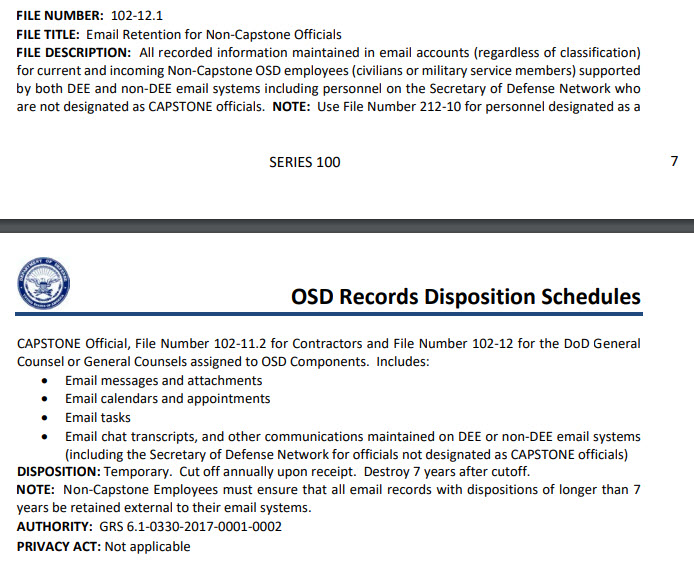 The entire description above applied to Elizondo’s work background, and with that, per OSD Series 100, Elizondo’s e-mails should have been maintained until October 4, 2024, seven years after his resignation, as defined in the schedule. Elizondo was asked if he felt that the above schedule would apply to his position, and he confirmed that it absolute would.
The entire description above applied to Elizondo’s work background, and with that, per OSD Series 100, Elizondo’s e-mails should have been maintained until October 4, 2024, seven years after his resignation, as defined in the schedule. Elizondo was asked if he felt that the above schedule would apply to his position, and he confirmed that it absolute would.
After further consultation, Elizondo has put forward numerous other categories in Series 500 which he felt applied to his records. This included, sections 504-05, Intelligence, Special subject files; section 503, Intelligence, Surveillance and Warning; and section 502-07, General Systems – Policy Correspondence and Coordination, which included correspondence with and coordination of intelligence activities within the Department of Defense and with other U.S. Government entities. Each of these categories, should they apply to Elizondo’s e-mails, would define the records retention schedule as “permanent” and only transferred for the National Archives and Records Administration (NARA) after 25 years for permanent holding. If Elizondo’s e-mails applied to just one of these, then their destruction was not authorized at all, nor would it ever be.
The Elusive Truth About The Destruction of E-Mails
When it comes to Elizondo’s e-mails, The Black Vault had filed at least eight FOIA requests over the past few years, seeking out keyword searches that would likely add insight and clarification to the many stories that have circulated. Words like “Unidentified,” “AATIP,” “AAWSAP,” “UAP,” “Community of Interest,” “To The Stars,” “DeLonge,” and “Puthoff” were just some of the requests filed to see what e-mails may surface during the course of Elizondo’s career. Yet oddly, many of these requests yielded “no records” responses, with no further clarification. In other words, according to Elizondo’s former employer, they could not find any messages were ever sent or received by Elizondo with the aforementioned keywords. Never was there a discussion that the e-mail box did not exist.
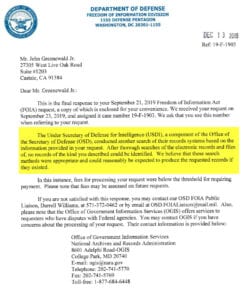
Numerous appeals were filed seeking additional searches. Using evidence in the form of Elizondo’s own public testimony, and previously released records, the DOD agreed that many of those appeals submitted by The Black Vault should be granted and new searches would be done.
Generally, agencies will stipulate when records are destroyed (or at least, thought to be destroyed). The Black Vault has numerous examples to cite when “no records” responses are given under such circumstances. However, in these cases regarding Elizondo’s e-mails, that was never done in the numerous “no records” denials. They simply said there were “no records” found, indicating they searched his e-mail box(es) but found nothing with the keywords specified.
In one particular example, The Black Vault’s FOIA case 19-F-1903, requested, “all e-mails, sent to and/or from Luis Elizondo… with the following keyword: ‘Unidentified.’” The case originally yielded the “no records” response on December 13, 2019. After an appeal was filed three days later, it was granted and the request was returned to the FOIA officers for re-processing.
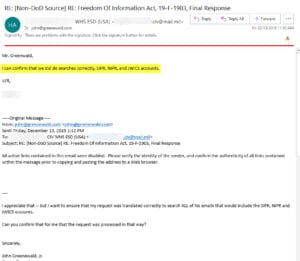
There were numerous exchanges between The Black Vault and the FOIA officer on this case which would confirm that a) NIPR, SIPR and JWICS networks (each system holds different levels of classified information up to the Top Secret level) had been searched, along with b) ensuring that the entire timeframe of Elizondo’s employment would be explored to ensure all responsive records would be found. During the course of these communications, never was it said that e-mail boxes were destroyed or did not exist. Rather, it was confirmed that the three accounts were searched across the three systems while processing the original request.
It would then take more than a year to finally close this particular case. On April 1, 2021, (irony of the date noted) the DOD issued another “no records” determination and said they found no e-mails sent to/from Elizondo containing the word “Unidentified.” However, this time, additional language had been added to the response letter.
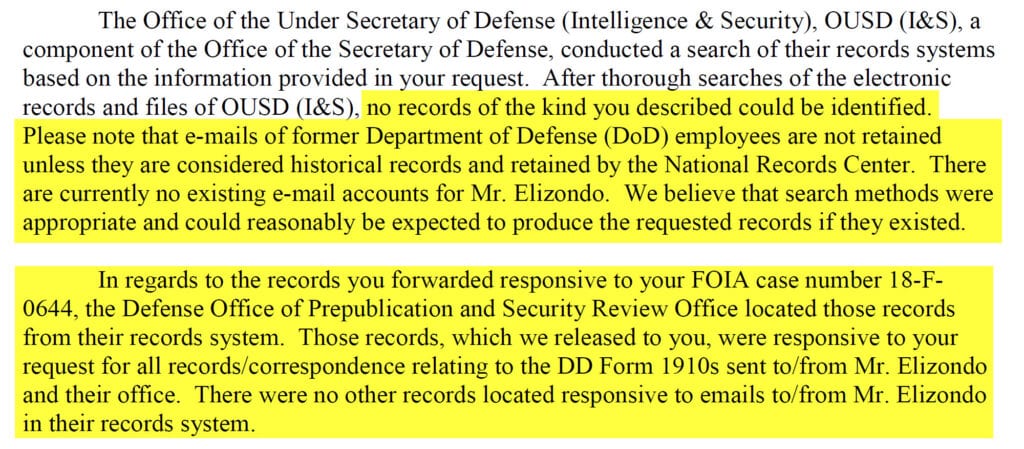
It was this language that showed that the material sought after for more than three years, throughout numerous FOIA cases and appeals, was entirely gone.
 Was It Deliberate?
Was It Deliberate?
Regardless of records retention or disposition schedules, many will theorize that the deletion of e-mails was another targeted attempt to continue the smear campaign of Elizondo. When asked about this, Elizondo would not speculate.
“I do not want to speculate on the possibility if this was an intentional act. I shutter at the thought that someone in a position of authority would purposely destroy historically significant records for the purpose of obfuscation and deceit; possibly crossing the boundaries of criminal activity,” Elizondo added. “For this reason, I prefer to let the system respond to your inquiry. However, it is no surprise to many that for the last 3 years I have been targeted by some in the Pentagon for retribution, which continues to this day. I truly hope this is not related.”
The Way Forward
The destruction of Elizondo’s e-mails is a crushing blow to the investigation process, but it is not a final one. Given the likelihood the AATIP program would have generated numerous other records and reports outside of an e-mail box; hope is not completely lost for future document releases that may answer some long-standing questions. That will just take time, and many of those FOIA cases that should yield such revelations have now remained open for years, as filed by The Black Vault beginning in 2017.
Hope may also not be totally lost on Elizondo’s e-mails, either. The Black Vault, in the weeks prior to the publishing of this article, filed numerous FOIA requests throughout multiple government agencies, seeking out additional documentation which may even include e-mails sent to/from Elizondo. Although documentation of any kind can be destroyed at the agency level, there are sometimes ways to potentially get that information elsewhere. It has happened before and may even just happen again.
Often with FOIA, as one door closes, two or three swing open with new opportunities and avenues to traverse. In this particular case regarding Elizondo, it may just be there are quite a few more than just two or three doors that have now presented themselves.
FOIA may soon shine light on material that some want you to believe is gone for good.
But that will be a story for another day…
###
Full Statements
The following were statements submitted to The Black Vault for this article. They are published here, in full, to show them in their entirety.
Luis Elizondo

“If the statement by the Pentagon is true, which I am not convinced that it is, this would be a significant loss of information that belongs to the public and may even be relevant to future legal efforts. It is also becoming increasingly evident that the destruction of my e-mails, etc may be a convenient tactic to obscure the truth of my involvement in national security activities. I sincerely hope this is not the case.”
“Even at the unclassified level, any correspondence would be considered relevant to the discovery process pertaining certain aspects of my job title, duties, and performance in other areas. In fact, it would be considered as relevant towards evidence from both a prosecutorial and defense perspective.”
“I do not want to speculate on the possibility if this was an intentional act. I shutter at the thought that someone in a position of authority would purposely destroy historically significant records for the purpose of obfuscation and deceit; possibly crossing the boundaries of criminal activity. For this reason, i prefer to let the system respond to your inquiry. However, it is no surprise to many that for the last 3 years i have been targeted by some in the Pentagon for retribution, which continues to this day. I truly hope this is not related.”
Regarding being “actively engaged” in the UAPTF:
“As we have seen time, and time again regarding the Pentagon’s responses, they still cant get their story straight. It should be no surprise that the consequence of this has now resulted in an official DoD IG Evaluation regarding the Pentagon’s handling of this topic. As recently as this week, the Pentagon PAO changed their stance again on the purpose of AATIP, partially admitting what we already knew for years. As for my work behind the scenes to support UAP Task Force efforts, I have been patient in allowing the Pentagon to address this in a manner they are comfortable provided they do not lie. Unfortunately, it now seems they are choosing once again to obscure the truth. As in other instances, I have initiated efforts internally that will hopefully encourage the Pentagon PAO to provide more truthful information to the public. Beyond that, I care to withhold additional comment at this point and allow every opportunity for the system to correct itself. However, my reserve is not endless, nor is my patience.”
Susan Gough
 “I refer to Mr. Reid’s office. We have no comment on his letter.”
“I refer to Mr. Reid’s office. We have no comment on his letter.”
“Assigned responsibilities are an individual employee’s duties.”
“Luis Elizondo had no assigned responsibilities for AATIP while he was assigned to the Office of the Under Secretary of Defense of Intelligence. Luis Elizondo departed the Department of Defense in October 2017. He has no position in the UAPTF, and the UAPTF has not involved him in its ongoing work.”
